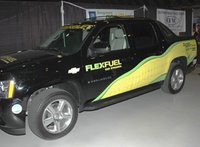
Friday's opening of the international Los Angeles Auto Show will feature the usual leggy models draped across carnauba-waxed chassis. It will showcase the usual engine housings, gleaming under spotlights, and futuristic dashboards twinkling like front-yard Christmas displays.
So begins veteran reporter Dan B. Wood of the Christian Science Monitor in his well-written review of Press Day at the
Los Angeles Auto Show.

Promoted as a tribute to the green turn the automobile industry is taking, the MPG ratings told the true story of this show - very few automobiles rated above 34 HWY. The buzzword was "power" not "efficiency" - style and glitz over substance. Hybrids were on display but pimped out rides like the Suzuki Xbox with its front and back game screens stole the imagination. Impractical concept sports cars abound at each manufacturer's booth at the expense of reminders about global warming and the oil crisis. In my opinion, GM did not focus adequate attention to their pricy Live Green/Go Yellow campaign publicized with great fanfare less than one year ago.
In striking contrast, fifteen miles away in green-and-proud-of-it Santa Monica a different tone was set.

The first day of the
Alt Car Expo brought car enthusiasts, environmental activists, politicians, celebrities, and families out to see a vision of the future test-driven on the tarmac, displayed in a hanger, and forecast in the seminar room. Many of the hybrids featured plug-ins and were rated at 100+ MPG. Several cars were all electric including one solar-powered Prius with solar cells embedded in its roof.
 Star Sighting!
Star Sighting!Emblematic of the difference of these two shows was one of the last EV-1 automobiles in public existence. In defiant red, this non-functioning but fully loaded martyr of auto history - the star of
"Who Killed the Electric Car?" - had to be hauled to this site on a flatbed truck and manually pushed into position. Hopefully this is not the eventual fate of the American auto industry. The only GM presence at this show was a GM Avalanche flex-fuel pick-up truck - neither Ford nor Chrysler had any presence at all.

In addition to the wide variety of vehicles on display during
Media Day, attendees were able to visit the
exhibition booths of about sixty-five vendors and organizations. Spotted in the crowd were auto legend
Lee Iacocca, environmentalist
Ed Begley, Jr., former L.A. Councilmember and urban planner
Michael Woo, and CA Assemblymember
Fran Pavley, author of numerous emissions capping bills in California.
It was in the seminar room that speakers provided the pulse of the show - defining current environmental and business conditions, advocating a broad range of solutions, and making predictions for the future. More than one "railed against machine" including former Cal/EPA director
Terry Tamminen who blasted the oil and automobile industry for their feckless stewardship of our energy and transportation needs. But all spoke about the possibilities of the future given the ingenuity and coordination of effort between industrialists, consumers, environmentalists, and political leadership. The consequences of inertia couldn't be more clear - unstable geopolitics, global warming, cultural friction, decaying infrastructure, energy price gouging, commuter standstill. The status quo is not an option.
 James Woolsey's Presentation
James Woolsey's PresentationFormer CIA Director
James Woolsey is a staunch advocate for advancing national security and public health by reducing our dependence on fossil fuels. He gave the most engaging and reasoned presentation of the expo. I recorded his address and have paraphrased those portions dealing directly with the issues of this blog.
"We have vulnerabilities in our electricity grid that we need to fix... fortunately it is here for us to fix." "Not so with oil. Because the infrastructure is outside of the United States, it is susceptible to forces we are unable to control." He said that if terrorists for whatever reason were successful at destroying sulfur clearing towers in Saudi Arabia, it would interrupt production for years that would likely raise oil prices to around $200 per barrel. "That's devastating..." Centralization of oil reserves in the Middle East also enables them to drive down the cost of oil to bankrupt competition if they so please. It is not a free enterprise system - it is under OPEC control.
"What can we do? I think there are a number of alternatives. One that should not be on the front burner is hydrogen." The expense of infrastructure alone could approach $1 Trillion and there are other hurdles. A second set of options includes increased drilling, oil extraction, or coal to liquid conversion. But you would have to capture the carbon. This does not solve the problem of dependency on hydrocarbons.
BIOconversion"Two things I think are the most interesting and promising in the short term." First is
biomass and/or waste conversion to ethanol or other biofuels. Diesel fuels can also be made from agricultural waste. These are essentially carbon-neutral. "You are not digging up the carbon from beneath the ground." You are recycling carbon that is already a part of the above ground carbon cycle. We are not talking about a single process. We are talking about moving away from hydrocarbon and moving to carbohydrates. This would help national security in several ways including helping the rural areas of the country.
In addition, if we use cheap feedstock like municipal solid wastes for these biorefineries, we make it extremely hard for OPEC to undercut our cost of manufacturing fuels - which enhances national security.
 Plug-in hybrids
Plug-in hybrids"The final technology I think is promising is
plug-in hybrids (PHEVs)" The American public will be attracted to having the option of running their vehicles on electricity at 1-2¢ per mile vs. 10-20¢ per mile for gasoline. If you drive less than 20 miles per day, you may not need to use the gasoline/ethanol/biodiesel stored in your gas tank for long periods of time. "If you use ethanol (E85) in place of gasoline on a car that gets 100+miles per gallon, you are effectively getting roughly 500+MPG of gasoline."
"For those who say that don't get excited by any of this in the short term - they need to look at the possible mutually reinforcing effect of using renewable fuels and plug-in hybrids... If instead of spending $1 Trillion on hydrogen infrastructure we spend $50 per new car to make it flexible-fuel compatible with ethanol we have, I think, we have some exciting possibilities before us and not too far in the future."
technorati
bioenergy,
PHEV,
plug-in,
hybrid,
electric,
flex-fuel,
ethanol,
automobile
 December 2006 saw major developments in the commitment of whole industries to a new paradigm shift to renewable energy.
December 2006 saw major developments in the commitment of whole industries to a new paradigm shift to renewable energy.

































